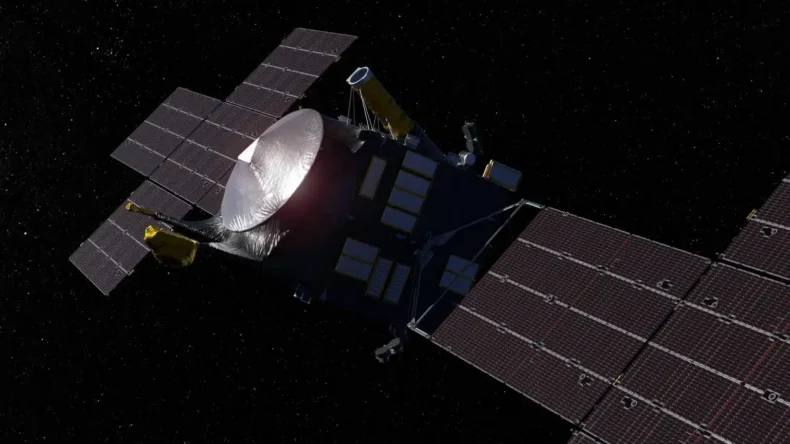The Psyche mission is a voyage to a special metal asteroid orbiting the Sun between Mars and Jupiter. The exposed nickel-iron core of an early planet, one of the components of our solar system, is what appears to distinguish the asteroid Psyche from other asteroids.
A metallic asteroid orbiting the sun between Mars and Jupiter is set to be investigated by NASA’s Psyche mission in 2024. On Friday, October 29, NASA made the decision to move forward with the Psyche project, with a launch window expected to open up on October 10, 2024, according to NASA’s official announcement. Due to challenges with the mission’s development, Psyche’s initial scheduled 2022 launch window was missed earlier this year, prompting an internal assessment of the mission’s ability to resolve these problems in time for its intended 2024 launch.
As NASA gears up for the launch in 2024, the mission team is still finishing up the testing process of the spacecraft’s flight software. The asteroid may contain metal from the core of a planetesimal, considered to be a basic structure of an early planetary body, and could possibly provide a rare perspective into the violent history of collisions and accretions that formed terrestrial planets like Earth. It is most likely made primarily of nickel-iron metal mixed with rock.
In 2017, NASA chose Psyche to examine a relatively similar, undiscovered metal-rich asteroid. It belongs to the agency’s Discovery Program, a group of competitive, low-cost missions run by a lone principle investigator.
The mission team is still working on testing the spacecraft’s flight software in order to meet the 2024 launch deadline. The new flight trajectory is the same as the one that was initially intended to launch in August 2022 and use Mars’ gravity assist in 2026 to bring the spacecraft toward the asteroid Psyche. The Psyche mission is scheduled to launch in October 2024 and is expected to touch down at the metal-rich asteroid in August 2029.
A project-proposed mission replan and a different, independent evaluation was commissioned in June by NASA and the agency’s Jet Propulsion Laboratory (JPL) in Southern California to look into the reasons for the delay, which served as the foundation for this continuation/termination review.

Thomas Zurbuchen, associate administrator of NASA’s Science Mission Directorate in Washington, said this about the mission: “The lessons learned from Psyche will be implemented across our entire mission portfolio. I am excited about the science insights Psyche will provide during its lifetime and its promise to contribute to our understanding of our own planet’s core.” Psyche could possibly provide a rare glimpse into the turbulent history of collisions and accretion that produced terrestrial planets such as Earth.
The Psyche mission is overseen by Arizona State University. JPL is in charge of the mission’s overall management, system engineering, integration and test, and mission operations for NASA and is run by the California Institute of Technology (Caltech) in Pasadena, California. The spaceship framework for the high-power solar electric propulsion is made by Maxar Technologies in Palo Alto, California. The launch is being overseen by NASA’s Launch Services Program, which has its headquarters at Florida’s Kennedy Space Center. The Marshall Space Flight Center in Huntsville, Alabama, oversees NASA’s Discovery Program, which manages the Psyche spacecraft.
The independent review board is still finishing up its findings, which will be released together with NASA’s comments once finalized. JPL Director Laurie Leshin said: “I’m extremely proud of the Psyche team. During this review, they have demonstrated significant progress already made toward the future launch date. I am confident in the plan moving forward and excited by the unique and important science this mission will return.”
The Janus project, which explores twin binary asteroid systems and was initially intended to launch alongside Psyche on a SpaceX Falcon Heavy rocket, is still under consideration by NASA. The Psyche spacecraft is integrated with NASA’s Deep Space Optical Communications technology demonstration, demonstrating high-data-rate laser communications, and it is expected to proceed as scheduled on the rescheduled launch date.
read more : NASA: Mission Juno gets a closer look at Jupiter’s Europa













